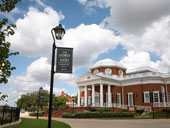Helping Students See Who They Want to Be
This article is over six months old and may reference former titles for DBU faculty or staff, discontinued programs, or other details that have since changed. If you have any questions, please contact us at news@dbu.edu, or (214) 333-5172.

Throughout my life, I have always seen education as a means to not only empower people but also to assist others in discovering who they are and what they can become.
One of my favorite highlights in nearly two decades of work in higher education has been the opportunity to visit elementary schools on career day. Often, schools would ask me to share with their students, primarily students from marginalized minority groups, about the joys of being a college professor. As I walked into the tiny classrooms dressed in my best 'teacher' uniform, I would write Professor Hearne boldly on the whiteboard, turn to the students, and say, "Now what do you want to be when you grow up?"
Regardless of the group, the answers would always bring a smile to my face. The students had a hope and a vision for what their life could be.
Imagine then how disjointed this image of young and hopeful faces stood in contrast to the events of May 25 as George Floyd lay in the street. It took 8 minutes and 46 seconds for a white officer to squeeze the life out of another black man in America. That image, combined with images of Ahmaud Arbery, Breonna Taylor, and so many others throughout the years, left people traumatized, scared, angered, and exasperated from these injustices and the lack of response expected to follow.
Reaction
In my attempt to process the confusion that followed these tragic deaths, I came across a viral image of a student being asked the same question that I asked every student in those classrooms, "What do you want to be when you grow up?" His answer floored me, "Alive, I want to be alive when I grow up." As an educator that answer was unacceptable.
Students should see who they want to be, starting with the curriculum in every classroom across America. Pedagogy and curriculum shape our imagination and our perceptions of reality and care for humanity.
By and large, students should receive a whole, varied education that decentralizes Eurocentric narratives and extends the knowledge to include a balanced picture of the contributions made by communities of color. Institutions that value diversity in education should encourage faculty to build courses that speak for and to the world around us and utilize curricula that reflects the often complicated and complete history of their discipline.
Additionally, professors in higher education have a responsibility to integrate culturally relevant material into the classroom. Students at public and private institutions have long expressed the need for multicultural, racial, and ethnic representation in the curriculum, whether it is choosing textbooks or research materials written by ethnic minority authors or publishers, inviting racially diverse guest lecturers into the classroom, or requesting that teachers teach with cultural perspectives in mind.
Far too often, the lack of inclusion has caused minorities to reject their unique experiences for the prevailing narrative. Langston Hughes' essay, "The Negro Artist and The Racial Mountain," recalled the impact of monolithic views on the literary arts and music in a story about his encounter with a rising black artist. The poet vehemently expressed a desire to be known as a poet rather than a black poet. Disappointed in the young man's haste to deny his racial identity during a period of black empowerment and renaissance in the arts, Hughes rebuffed, "This is the mountain standing in the way of any true Negro art in America—this urge within the race toward whiteness, the desire to pour racial individuality into the mold of American standardization, and to be as little Negro and as much American as possible...as though his own racial world were not as interesting as any other world."
Response
To overcome this mountain, professors are charged with the implementation of inclusive pedagogy that recognizes perspectives from marginalized racial and ethnic groups and humanizes the traditional teaching practice, thus creating what esteemed educational activist Parker Palmer described as a "community of truth."
A community of truth is a space where students can authentically engage with the discipline, the teacher, and each other. Diversifying the curriculum celebrates the extraordinary efforts of often-overlooked Black, Indigenous, Latinx, and other people of color in various fields of study. Teaching through the lens of diversity provides a unique opportunity to affirm all students' nuanced experiences. Furthermore, curricula that creatively acknowledges the cultural and social constructs in which systems, industries, and institutions are formed help normalize difficult conversations surrounding race and cultural differences.
Recently, I sat with a faculty colleague to reimagine the curriculum. We challenged each other during our meeting to resist the urge to solely present material from the "cultural default," being that of the dominant white male perspective. We discussed the dangers of telling a single story, a phrase coined by Chimamanda Ngozi Adichie in a recent Ted Talk by the same name. In our assessment of the syllabus, we acknowledged common concerns surrounding the erasure of white America's significant contributions to the subject matter and settled on the importance of organizing curriculum from a position of both/and not either/or.
More than any of this, however, diversifying curriculum is essential, not because it speaks to society's incessant demands, but rather because it is obedient to God's call for unity in the body of Christ.
Overcoming
Ephesians 4:25-29 tells us that in our respective callings, as one body in Christ, we must speak the truth and build others up according to their needs so that it may benefit those who listen. Senior Pastor of Oak Cliff Bible Fellowship, Dr. Tony Evans, reflected on God's call for unity in diversity respective to the field of education through his lived experience.
Dr. Evans wrote, "Growing up in urban America during the Civil Rights Era in a Christian context of racism, segregation, and an incomplete historical education didn't give me an opportunity to know who I really was. In my all-black classrooms, I learned about white culture and white history....Without an authentic self-awareness, African Americans often struggle as we seek to play on the same team toward the same goal in the body of Christ. But just as relevant is the need for awareness among my white brothers and sisters concerning who we are, and who God has created and positioned us to be at this critical time in our world."
The act of unity that Christ commands can be realized through curriculum that reasonably reflects the whole of creation for all of God's creations. To create a teaching environment where students feel seen, faculty should reevaluate what we teach and how we teach it. Every discipline has a historical past, a present shaped by that past, and a future beholden to them both. As teachers, we should ask ourselves whether the connections we aim to make within the curriculum elevates the experiences of the growing number of minority students longing to find a sense of who they are and who they want to be in our classrooms.
Sources
Baldwin, J. (1963, October 16). A talk with teachers. Delivered October 16, 1963, as "The Negro Child - His Self-Image," originally published in The Saturday Review.
Evans, T. (n.d.). Why Black history matters. Tony Evans | The Urban Alternative.
Hughes, L. (2009, October 13). The Negro artist and the racial mountain. Poetry Foundation.
Palmer, P.J. (2009). The courage to teach: Exploring the inner landscape of a teacher's life. John Wiley & Sons.
Tish Hearne serves as an Assistant Professor of Higher Education and the MEDHE Program Director for the Cook School of Leadership at DBU.








